ASRock Z87E-ITX Review: Motherboard Juxtaposition
by Ian Cutress on November 6, 2013 10:00 AM EST- Posted in
- Motherboards
- ASRock
- Mini ITX
- Haswell
- Z87
Computational Benchmarks
Readers of our motherboard review section will have noted the trend in modern motherboards to implement a form of MultiCore Enhancement / Acceleration / Turbo (read our report here) on their motherboards. This does several things – better benchmark results at stock settings (not entirely needed if overclocking is an end-user goal), at the expense of heat and temperature, but also gives in essence an automatic overclock which may be against what the user wants. Our testing methodology is ‘out-of-the-box’, with the latest public BIOS installed and XMP enabled, and thus subject to the whims of this feature. It is ultimately up to the motherboard manufacturer to take this risk – and manufacturers taking risks in the setup is something they do on every product (think C-state settings, USB priority, DPC Latency / monitoring priority, memory subtimings at JEDEC). Processor speed change is part of that risk which is clearly visible, and ultimately if no overclocking is planned, some motherboards will affect how fast that shiny new processor goes and can be an important factor in the purchase.
For reference, on BIOS 2.10 as tested, the Z87E-ITX does NOT implement MultiCore Turbo by default, and thus follows Intel specifications.
Point Calculations - 3D Movement Algorithm Test
The algorithms in 3DPM employ both uniform random number generation or normal distribution random number generation, and vary in various amounts of trigonometric operations, conditional statements, generation and rejection, fused operations, etc. The benchmark runs through six algorithms for a specified number of particles and steps, and calculates the speed of each algorithm, then sums them all for a final score. This is an example of a real world situation that a computational scientist may find themselves in, rather than a pure synthetic benchmark. The benchmark is also parallel between particles simulated, and we test the single thread performance as well as the multi-threaded performance.
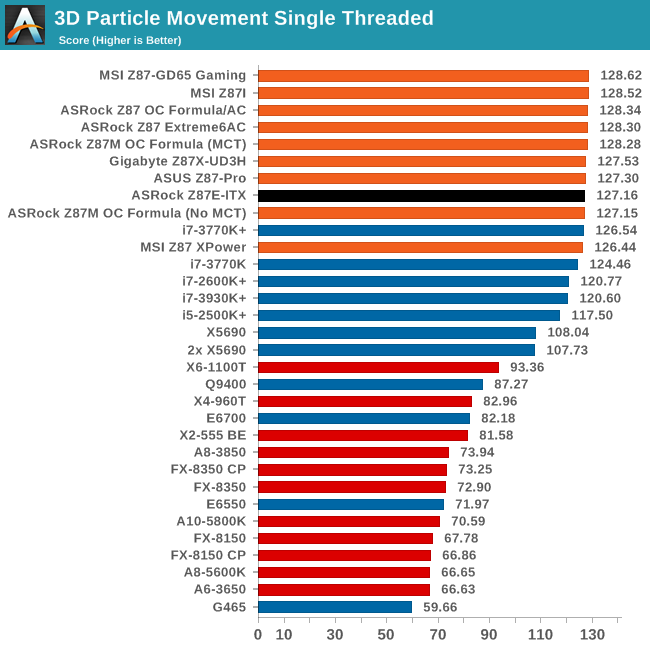
In single core performance, where MCT does not matter, the Z87E-ITX does not set any records alight, even performing near the rear end of our Z87 testing in line with the Z87 OC Formula with a No MCT BIOS.
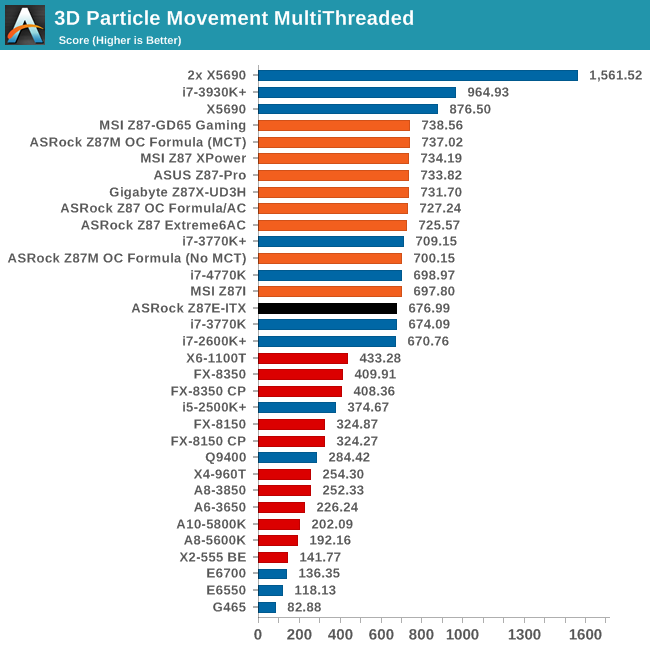
The lack of MCT should affect the multi-threaded test more, but the Z87E-ITX actually performs worse than expected, somewhere near a 3770K with MCT.
Compression - WinRAR 4.2
With 64-bit WinRAR, we compress the set of files used in the USB speed tests. WinRAR x64 3.93 attempts to use multithreading when possible, and provides as a good test for when a system has variable threaded load. WinRAR 4.2 does this a lot better! If a system has multiple speeds to invoke at different loading, the switching between those speeds will determine how well the system will do.
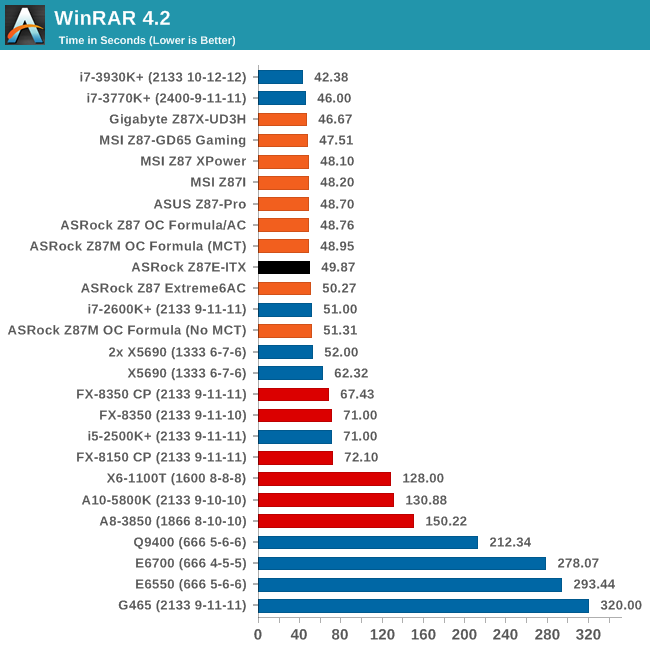
Surprisingly the Z87E-ITX performs better than the Z87 Extreme6/AC, which did have MCT enabled. It would seem that ASRock have optimized some of their turbo boosting routines from launch.
Image Manipulation - FastStone Image Viewer 4.2
FastStone Image Viewer is a free piece of software I have been using for quite a few years now. It allows quick viewing of flat images, as well as resizing, changing color depth, adding simple text or simple filters. It also has a bulk image conversion tool, which we use here. The software currently operates only in single-thread mode, which should change in later versions of the software. For this test, we convert a series of 170 files, of various resolutions, dimensions and types (of a total size of 163MB), all to the .gif format of 640x480 dimensions.

No surprises here – all motherboards taking 48-49 seconds in FastStone.
Video Conversion - Xilisoft Video Converter 7
With XVC, users can convert any type of normal video to any compatible format for smartphones, tablets and other devices. By default, it uses all available threads on the system, and in the presence of appropriate graphics cards, can utilize CUDA for NVIDIA GPUs as well as AMD WinAPP for AMD GPUs. For this test, we use a set of 33 HD videos, each lasting 30 seconds, and convert them from 1080p to an iPod H.264 video format using just the CPU. The time taken to convert these videos gives us our result.
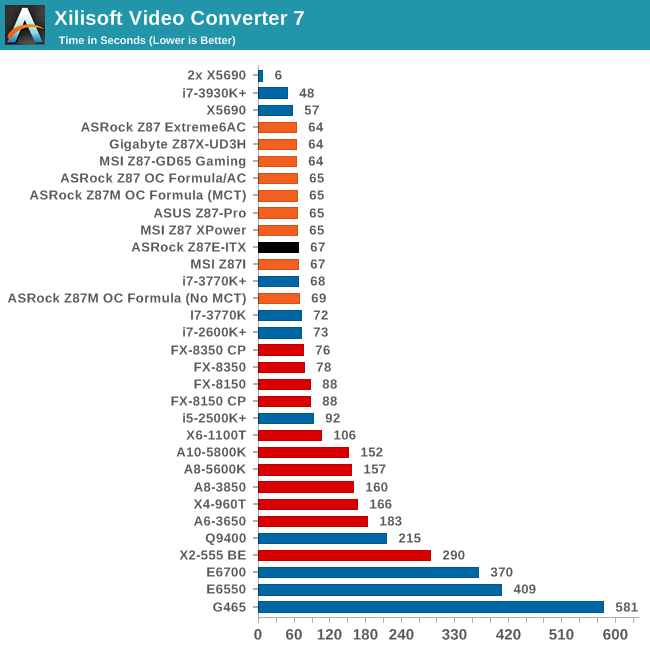
In the XVC test, the Z87E-ITX beats the OC Formula without MCT, and is actually on par with the MSI Z87I which did have MCT enabled.
Rendering – PovRay 3.7
The Persistence of Vision RayTracer, or PovRay, is a freeware package for as the name suggests, ray tracing. It is a pure renderer, rather than modeling software, but the latest beta version contains a handy benchmark for stressing all processing threads on a platform. We have been using this test in motherboard reviews to test memory stability at various CPU speeds to good effect – if it passes the test, the IMC in the CPU is stable for a given CPU speed. As a CPU test, it runs for approximately 2-3 minutes on high end platforms.
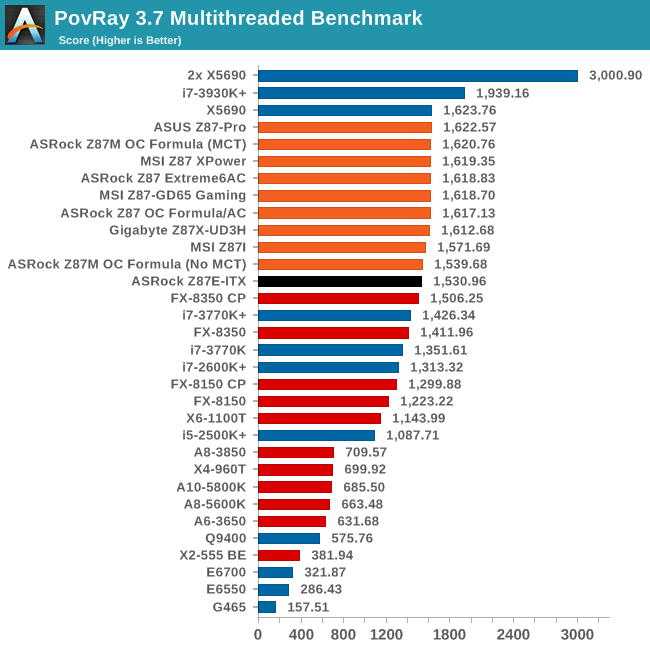
The Z87E-ITX joins the No MCT results from the OC Formula at the bottom of the Z87 testing for PovRay.
Video Conversion - x264 HD Benchmark
The x264 HD Benchmark uses a common HD encoding tool to process an HD MPEG2 source at 1280x720 at 3963 Kbps. This test represents a standardized result which can be compared across other reviews, and is dependent on both CPU power and memory speed. The benchmark performs a 2-pass encode, and the results shown are the average of each pass performed four times.
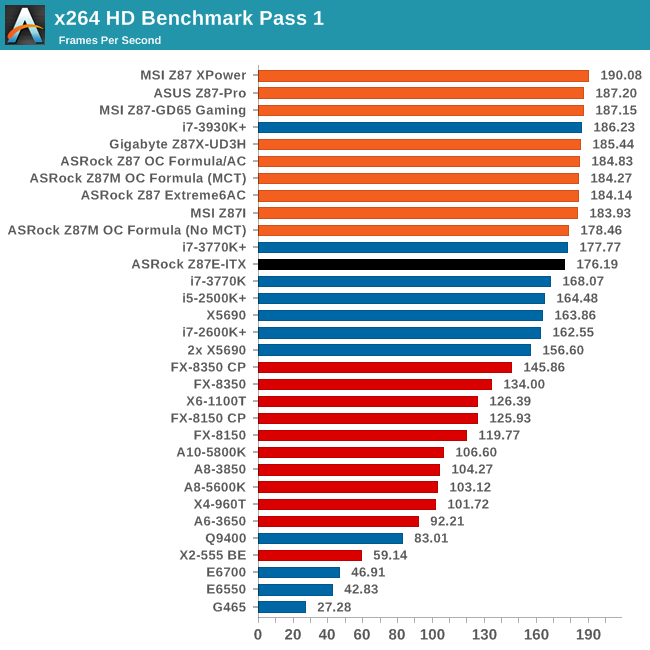
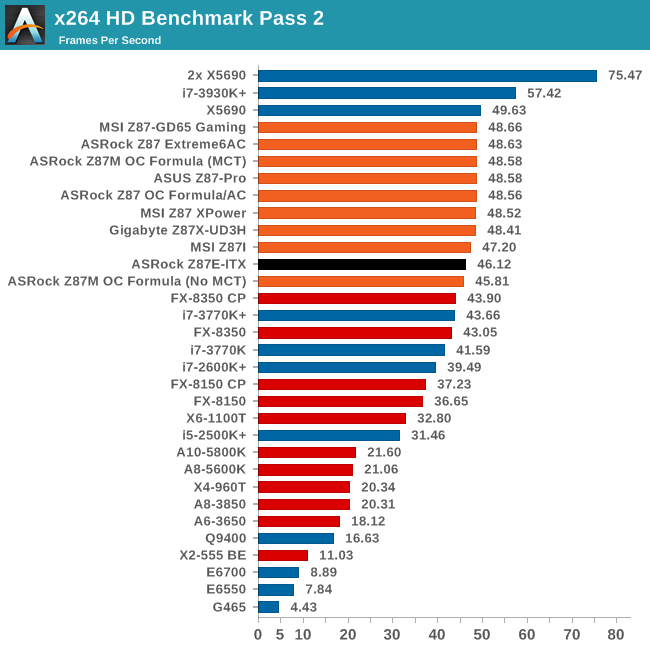
Grid Solvers - Explicit Finite Difference
For any grid of regular nodes, the simplest way to calculate the next time step is to use the values of those around it. This makes for easy mathematics and parallel simulation, as each node calculated is only dependent on the previous time step, not the nodes around it on the current calculated time step. By choosing a regular grid, we reduce the levels of memory access required for irregular grids. We test both 2D and 3D explicit finite difference simulations with 2n nodes in each dimension, using OpenMP as the threading operator in single precision. The grid is isotropic and the boundary conditions are sinks. Values are floating point, with memory cache sizes and speeds playing a part in the overall score.
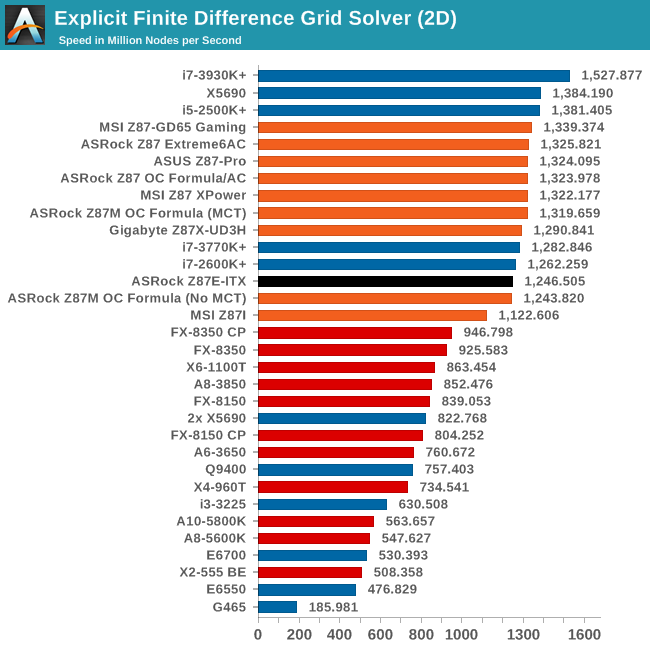
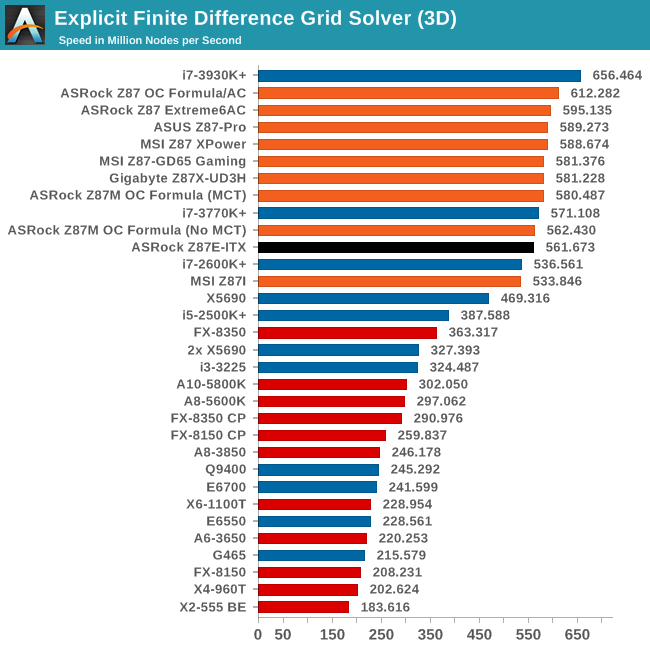
Explicit Finite Difference loves a bit of IPC, but due to the lack of MCT out of the box, the Z87E-ITX joins the other non-MCT results.
Grid Solvers - Implicit Finite Difference + Alternating Direction Implicit Method
The implicit method takes a different approach to the explicit method – instead of considering one unknown in the new time step to be calculated from known elements in the previous time step, we consider that an old point can influence several new points by way of simultaneous equations. This adds to the complexity of the simulation – the grid of nodes is solved as a series of rows and columns rather than points, reducing the parallel nature of the simulation by a dimension and drastically increasing the memory requirements of each thread. The upside, as noted above, is the less stringent stability rules related to time steps and grid spacing. For this we simulate a 2D grid of 2n nodes in each dimension, using OpenMP in single precision. Again our grid is isotropic with the boundaries acting as sinks. Values are floating point, with memory cache sizes and speeds playing a part in the overall score.
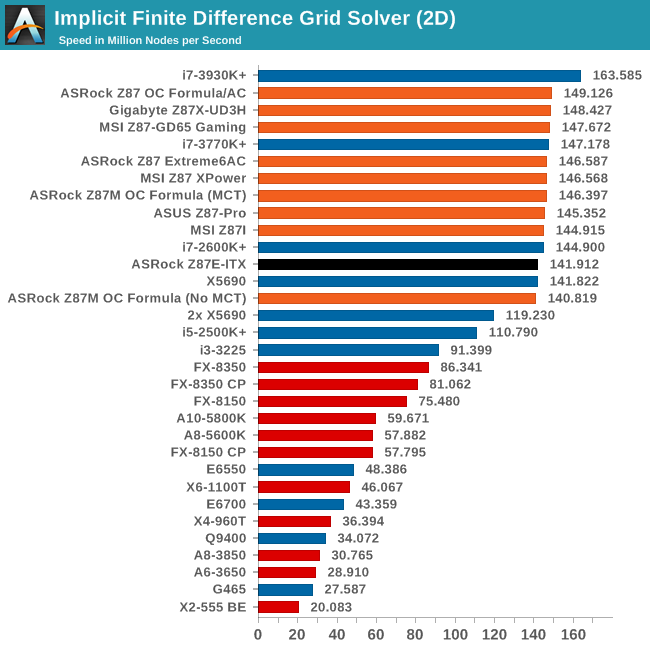
Point Calculations - n-Body Simulation
When a series of heavy mass elements are in space, they interact with each other through the force of gravity. Thus when a star cluster forms, the interaction of every large mass with every other large mass defines the speed at which these elements approach each other. When dealing with millions and billions of stars on such a large scale, the movement of each of these stars can be simulated through the physical theorems that describe the interactions. The benchmark detects whether the processor is SSE2 or SSE4 capable, and implements the relative code. We run a simulation of 10240 particles of equal mass - the output for this code is in terms of GFLOPs, and the result recorded was the peak GFLOPs value.
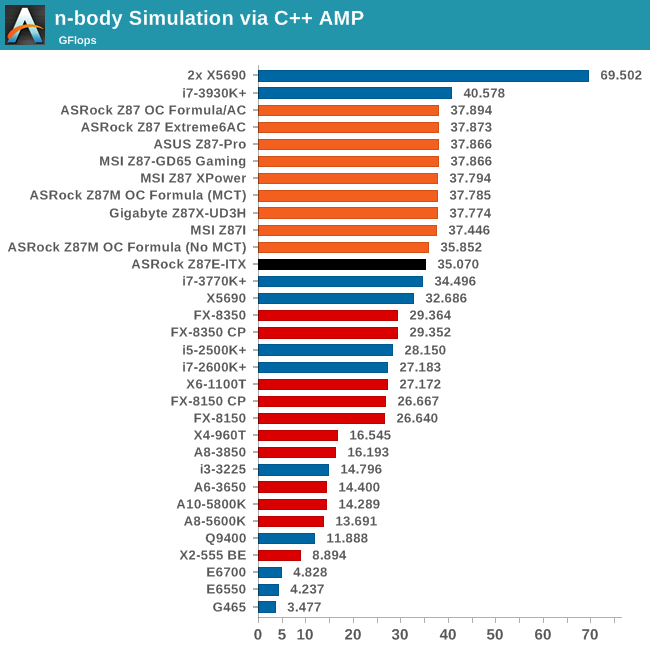










43 Comments
View All Comments
duynguyenle - Wednesday, November 6, 2013 - link
You can get the manual here http://www.asrock.com/MB/overview.asp?cat=Manual&a...The section on storage quoted:
6 x SATA3 6.0 Gb/s connectors, support RAID (RAID 0,
RAID 1, RAID 5, RAID 10, Intel Rapid Storage Technology
12 and Intel Smart Response Technology), NCQ, AHCI and
“Hot Plug” (SATA3_5 connector is shared with the eSATA
port; SATA3_4 connector is shared with the mSATA/mini-
PCI Express slot)
So it looks like the eSATA and mSATA ports are shared with the physical SATA ports 3 and 4, giving you only 6 maximum HDDs
Samus - Wednesday, November 6, 2013 - link
For example, the H87 version of this board has four physical SATA ports and one eSATA giving 5 total ports. The 87-chipset only has six SATA 6Gbps channels total.zlandar - Wednesday, November 6, 2013 - link
I see 6 SATA ports in a row on the motherboard. The eSATA and mSATA are in addition to the 6 SATA ports.duynguyenle - Wednesday, November 6, 2013 - link
Just because there are 6 SATA ports doesn't mean you can use all 6 IN ADDITION to the mSATA and eSATA ports. Quite often, the physical ports share electrical connection with mSATA and eSATA connectors, meaning that if you plug in a mSATA drive onto the motherboard, you will disable the SATA connector it's shared with.In fact, the user manual here (http://www.asrock.com/MB/overview.asp?cat=Manual&a... states that the mSATA and eSATA ports are shared with onboard SATA ports number 3 and 4, respectively, meaning that you only get a maximum of 6 HDDs in any combination of onboard SATAs+mSATA+eSATA
abscode - Wednesday, November 6, 2013 - link
My media server/file server/HTPC is built around this board and has been on 24/7 since it's release week. It's been absolutely solid and trouble free. Recently built a developer workstation around the Asus Z87I-Deluxe and that one has been excellent too.vortexmak - Wednesday, November 6, 2013 - link
Ian or someone who has this board, can you please check if Wifi and Bluetooth works on Linux/Ubuntu ? My purchasing decision rests on this.PS: You can use an ubuntu bootable CD. Thanks for all the help :)
vortexmak - Wednesday, November 6, 2013 - link
Where does the power for eSATA come from ? Do you have to use an external power supply ?Will AT be reviewing the Gigabyte Z87 ITX board as well ?
Thanks
DanNeely - Wednesday, November 6, 2013 - link
eSATA is an unpowered interface. I've seen a few boards offering combination eSATA/USB2 ports that could theoretically combine power and data into a single cable; but I don't recall ever seeing a device that used one. Part of that issue is probably that at the time USB power was limited to 2.5W; and most eSATA enclosures were for 3.5" drives which needed a brick to provide enough power to operate.bobbozzo - Thursday, November 7, 2013 - link
If your case has an empty slot, you can get brackets with Molex and/or SATA power connectors.Here's one with 2 eSATA, 1 Molex, and external cables for Molex -> SATA power:
www.amazon.com/dp/B000YI7M3G
stennan - Wednesday, November 6, 2013 - link
Will you be doing any matx motherboards soon. I have my eyes on the gryphon or the gene 6. The question is how I should add wifi and if I should add a dedicated soundcard. It partly hinges on if true audio takes off and if the 290 will be quiet enough for the small case I have in mind.